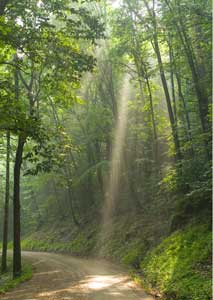Blue Ridge National Park
The Blue Ridge Parkway, sometimes called "America's Favorite Drive", is the most visited unit of America's National Park System. A drive down the Parkway provides stunning, long range vistas and close-up looks at the natural and cultural history of the southern Appalachian mountains.
While many people think of the Blue Ridge Parkway just as a motor road, it is also a place of varied and significant natural resources. The Parkway follows the high crests of the central and southern Appalachians for 469 miles from Shenandoah National Park in Virginia to the Great Smoky Mountains National Park in North Carolina.
Along this route an unsurpassed diversity of climate zones, vegetation zones, physiographic zones, and geological features are traversed. The more than 81,000 acres of Parkway lands pass through a highland area of five degrees longitude and approximately 3 degrees latitude, making it the third largest unit of the National Park Service in terms of area covered. Park resources include 400 streams (150 headwaters), 47 Natural Heritage Areas (areas set aside as national, regional or state examples of exemplary natural communities), a variety of slopes and exposures, and possibly 100 different soil types. With an elevation range of 5,700 feet the Parkway provides a home for both southern species at the lower elevations and northern species on the mountaintops.
Taking advantage of this diversity are 14 major vegetation types, about 1,250 vascular plant species (50 threatened or endangered), and almost 100 species of non-native plants. Nearly 100 species of trees grow along the Parkway, about as many as are found in all of Europe. Added to that are estimates of almost 400 species of mosses and nearly 2000 species of fungi.
Not to be outdone by the plants, many species of animals make their homes along the Parkway. Fifty-four different mammals, more than 50 salamanders and 40 reptiles can be found on Parkway lands. One hundred fifty-nine species of birds are known to nest here with dozens of others passing through during fall and spring migrations.
The Parkway's strikingly different vegetative life zones, successive floral displays, autumn foliage, geological features, and animals are major attractions each year for 20 million visitors (the highest visitation in the NPS system). For them the Parkway is indeed more than just a road.
